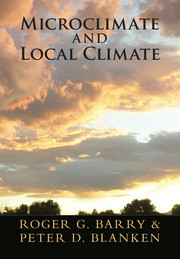Book contents
- Frontmatter
- Contents
- Preface
- Acknowledgments
- 1 Introduction
- Part I Controls of Microclimate
- 2 Microclimatic Elements
- 3 Methods of Observation and Instrumentation
- 4 Radiation
- 5 The Energy Balance
- 6 Monitoring Radiation, Energy, and Moisture Balance via Remote Sensing and Modeling with Land Surface Models
- 7 Microclimates of Different Vegetated Environments
- 8 Microclimates of Physical Systems
- 9 Bioclimatology
- Part II Local (Topo-)Climates
- Part III Environmental Change
- Problems
- Glossary
- Symbols
- System International (SI) Units and Conversions
- Index
- References
2 - Microclimatic Elements
from Part I - Controls of Microclimate
Published online by Cambridge University Press: 05 May 2016
- Frontmatter
- Contents
- Preface
- Acknowledgments
- 1 Introduction
- Part I Controls of Microclimate
- 2 Microclimatic Elements
- 3 Methods of Observation and Instrumentation
- 4 Radiation
- 5 The Energy Balance
- 6 Monitoring Radiation, Energy, and Moisture Balance via Remote Sensing and Modeling with Land Surface Models
- 7 Microclimates of Different Vegetated Environments
- 8 Microclimates of Physical Systems
- 9 Bioclimatology
- Part II Local (Topo-)Climates
- Part III Environmental Change
- Problems
- Glossary
- Symbols
- System International (SI) Units and Conversions
- Index
- References
Summary
In this chapter we discuss the basic characteristics of the major climatic elements – temperature, moisture in the air and soil, wind, and carbon dioxide – in both a global and a microclimatological context. We also consider the processes of photosynthesis, respiration and carbon exchange, and the nitrogen cycle. Finally, pollutants and aerosols are discussed. This provides a basic introduction to the elements that are used in characterizing micro- and local climates.
Temperature
Air Temperature
Temperature is a measure of the kinetic energy of an object. Air temperatures have traditionally been measured by mercury or alcohol in glass thermometers at a height of 1.5–2.0 m above ground in a louvered box known as a Stevenson screen or weather shelter (to prevent solar heating). Air temperatures at the Earth's surface generally range between about –50 °C and +50 °C. The coldest locations, outside the Greenland and Antarctic ice sheets, are in northeastern Siberia in winter, and the hottest ones are in the subtropical deserts of North Africa and the Arabian Peninsula in summer.
At meteorological stations, readings are typically made every six hours (00, 06, 12, and 18 UTC, Coordinated Universal Time), but at climatological stations there may be only readings of the daily maximum and minimum temperatures. Temperature measurements are widely made around the world (more than 20,000 stations) and in Europe there are data going back more than 300 years. Most instrumental records begin around 1850.
As well as the dry-bulb temperature reading, a wet-bulb is operated: the thermometer bulb is wrapped in a muslin bag that is kept wet. The depression of the wet-bulb reading with respect to the dry-bulb is used to determine the dew point temperature and relative humidity. This instrument, known as a psychrometer, is described in Chapter 3, Section H.
The true daily mean temperature is obtained as the arithmetic mean of 24 hourly readings, but often the average of the daily maximum and minimum temperatures using a “max-min thermometer” is used since this requires a reading only once per 24 hours. This gives a biased value, however, often negative in winter and positive in summer, with a higher standard deviation. Variables of interest include the daily and monthly mean values, the absolute monthly maxima and minima, and derived indices such as frequency distributions and freezing and thawing indices.
- Type
- Chapter
- Information
- Microclimate and Local Climate , pp. 11 - 51Publisher: Cambridge University PressPrint publication year: 2016



